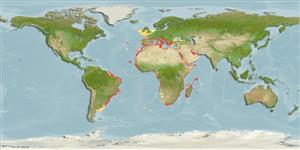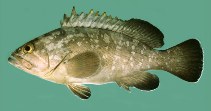Epinephelus marginatus (Lowe, 1834)
Dusky grouper
Add your observation in Fish Watcher
| Native range | All suitable habitat | Point map | Year 2050 |

|
| This map was computer-generated and has not yet been reviewed. |
| Epinephelus marginatus AquaMaps Data sources: GBIF OBIS |
Upload your photos and videos
Pictures | Videos | Stamps, coins, misc. | Google imageEpinephelus marginatus
Picture by Randall, J.E.
Pictures | Videos | Stamps, coins, misc. | Google imageEpinephelus marginatus
Picture by Randall, J.E.
Cyprus country information
Common names:
[No common name]
Occurrence: native
Salinity: marine
Abundance: | Ref:
Importance: | Ref:
Aquaculture: | Ref:
Regulations: | Ref:
Uses: no uses
Comments: Also Ref. 4787, 95825. Museum: HUJ 10242, 9047.
National Checklist:
Country Information: https://www.cia.gov/library/publications/resources/the-world-factbook/geos/cy.html
National Fisheries Authority:
Occurrences: Occurrences Point map
Main Ref: Heemstra, P.C. and J.E. Randall, 1993
National Database:
Occurrence: native
Salinity: marine
Abundance: | Ref:
Importance: | Ref:
Aquaculture: | Ref:
Regulations: | Ref:
Uses: no uses
Comments: Also Ref. 4787, 95825. Museum: HUJ 10242, 9047.
National Checklist:
Country Information: https://www.cia.gov/library/publications/resources/the-world-factbook/geos/cy.html
National Fisheries Authority:
Occurrences: Occurrences Point map
Main Ref: Heemstra, P.C. and J.E. Randall, 1993
National Database:
Common names from other countries
Classification / Names Common names | Synonyms | Catalog of Fishes(genus, species) | ITIS | CoL | WoRMS | Cloffa
Teleostei (teleosts) > Perciformes/Serranoidei (Groupers) > Epinephelidae (Groupers)
Etymology: Epinephelus: Greek, epinephelos = cloudy (Ref. 45335).
More on author: Lowe.
Etymology: Epinephelus: Greek, epinephelos = cloudy (Ref. 45335).
More on author: Lowe.
Environment: milieu / climate zone / depth range / distribution range Ecology
Marine; reef-associated; depth range 8 - 300 m (Ref. 27000), usually ? - 50 m (Ref. 5222). Subtropical; 54°N - 43°S, 65°W - 58°E (Ref. 5222)
Distribution Countries | FAO areas | Ecosystems | Occurrences | Point map | Introductions | Faunafri
East and Southwest Atlantic and Western Indian Ocean: East Atlantic: throughout the Mediterranean Sea, and from the southern Bay of Biscay to southern tip of Africa. Stray specimens reported from the British Isles, and eastern English Channel (Normandy, France; Ref. 92236). Southwest Atlantic: southeastern Brazil, Uruguay, and Argentina. Western Indian Ocean: from tip of Africa to southern Mozambique and southern Madagascar. Reported from Oman and La Reunion I.
Length at first maturity / Size / Weight / Age
Maturity: Lm 49.2, range 37 - 54 cm
Max length : 150 cm TL male/unsexed; (Ref. 12382); max. published weight: 60.0 kg (Ref. 5222); max. reported age: 60 years (Ref. 94520)
Max length : 150 cm TL male/unsexed; (Ref. 12382); max. published weight: 60.0 kg (Ref. 5222); max. reported age: 60 years (Ref. 94520)
Short description Identification keys | Morphology | Morphometrics
Dorsal spines (total): 11; Dorsal soft rays (total): 14 - 16; Anal spines: 3; Anal soft rays: 8 - 9. Diagnosis: head and body dark reddish brown or greyish dorsally, usually yellowish gold ventrally; irregular white, pale greenish yellow or silvery grey blotches usually visible on the body and head and mostly arranged in vertical series; more or less distinct black maxillary streak; dark brown median fins; distal edge of anal and caudal fins, often also pectoral fins, narrowly white; pelvic fins blackish distally; pectoral fins dark reddish brown or grey; margin of spinous dorsal fin and basal part of the paired fins often golden yellow; head length 2.3-2.5 in SL; convex interorbital area; rounded preopercle, finely serrate, serrae at angle slightly enlarged; smooth subopercle and interopercle; eye diameter greater than or subequal to interorbital width in fish 10-30 cm SL, less than interorbital in fish over 40 cm SL; posterior and anterior nostrils subequal or posterior nostril slightly larger; maxilla naked, reaching to or slightly past vertical at rear edge of eye; 2-4 rows of subequal teeth on midlateral part of lower jaw (Ref. 89707).
Adults prefer rocky bottoms (Ref. 5222), are solitary and territorial (Ref. 12382). Juveniles are found closer to shore (Ref. 48605) in rocky tidal pools (Ref. 48609). Enters brackish environments (Ref. 57293). Mainly feed on crabs and octopi; larger individuals feed on a greater proportion of fishes, the majority of which are reef-associated species (Ref. 6842). A protogynous hermaphrodite (Ref. 55367). Mature individuals form spawning aggregations (Ref. 55367). Utilized as a food fish (Ref. 171). Readily caught by anglers (Ref. 5222). Not adapted well in an aquarium (Ref. 12382).
Life cycle and mating behavior Maturity | Reproduction | Spawning | Eggs | Fecundity | Larvae
A monandric species (Ref. 55367). In Europe, sex reversal occurs when females are about 14-17 years of age and between 80 to 90 cm TL (Ref. 51466). From another study, sex change occurs at 88 cm TL and 12 years of age (Ref. 55367), between 52-77 cm TL and 7-17 years (Ref. 94520).
Protogynous hermaphrodite species, reaching its first sexual maturity as female at 5 years and becoming male after 10 years (some females remain so for some more years). Spawning happens during summer.
Main reference
Upload your references | References | Coordinator | Collaborators
Heemstra, P.C. and J.E. Randall, 1993. FAO Species Catalogue. Vol. 16. Groupers of the world (family Serranidae, subfamily Epinephelinae). An annotated and illustrated catalogue of the grouper, rockcod, hind, coral grouper and lyretail species known to date. Rome: FAO. FAO Fish. Synop. 125(16):382 p. (Ref. 5222)
IUCN Red List Status (Ref. 130435: Version 2024-2)
Vulnerable (VU) (A2bd+4bd); Date assessed: 20 November 2016
Threat to humans
Harmless
Human uses
Fisheries: highly commercial; gamefish: yes
FAO(Fisheries: production; publication : search) | FishSource | Sea Around Us
More information
Population dynamics
Growth parameters
Max. ages / sizes
Length-weight rel.
Length-length rel.
Length-frequencies
Mass conversion
Recruitment
Abundance
Growth parameters
Max. ages / sizes
Length-weight rel.
Length-length rel.
Length-frequencies
Mass conversion
Recruitment
Abundance
Life cycle
Reproduction
Maturity
Fecundity
Spawning
Spawning aggregations
Eggs
Egg development
Larvae
Larval dynamics
Reproduction
Maturity
Fecundity
Spawning
Spawning aggregations
Eggs
Egg development
Larvae
Larval dynamics
Anatomy
Gill area
Brain
Otolith
Gill area
Brain
Otolith
Physiology
Body composition
Nutrients
Oxygen consumption
Swimming type
Swimming speed
Visual pigments
Fish sound
Diseases & Parasites
Toxicity (LC50s)
Body composition
Nutrients
Oxygen consumption
Swimming type
Swimming speed
Visual pigments
Fish sound
Diseases & Parasites
Toxicity (LC50s)
Tools
Bio-Quiz | E-book | Field guide | Identification keys | Length-frequency wizard | Life-history tool | Point map | Classification Tree
| Catch-MSY |
Special reports
Download XML
Internet sources
Aquatic Commons | BHL | Cloffa | Websites from users | Check FishWatcher | CISTI | Catalog of Fishes(genus, species) | DiscoverLife | DORIS | ECOTOX | Faunafri | Fishtrace | GenBank(genome, nucleotide) | GloBI | GOBASE | | Google Books | Google Scholar | Google | IGFA World Record | MitoFish | National databases | Otolith Atlas of Taiwan Fishes | Public aquariums | PubMed | Reef Life Survey | Scirus | SeaLifeBase | Tree of Life | Wikipedia(Go, Search) | World Records Freshwater Fishing | Zoological Record
Estimates based on models
Preferred temperature (Ref. 115969): 13.3 - 25.8, mean 19 (based on 33 cells).
Phylogenetic diversity index (Ref. 82804): PD50 = 0.5000 [Uniqueness, from 0.5 = low to 2.0 = high].
Bayesian length-weight: a=0.01047 (0.00677 - 0.01621), b=3.06 (2.94 - 3.18), in cm Total Length, based on LWR estimates for this species & Genus-body shape (Ref. 93245).
Trophic level (Ref. 69278): 4.4 ±0.0 se; based on diet studies.
Resilience (Ref. 120179): Low, minimum population doubling time 4.5 - 14 years (K=0.03-0.09; tmax=50; tm=7).
Prior r = 0.36, 95% CL = 0.24 - 0.55, Based on 5 data-limited stock assessments.
Fishing Vulnerability (Ref. 59153): High vulnerability (64 of 100).
Climate Vulnerability (Ref. 125649): Moderate vulnerability (38 of 100).




